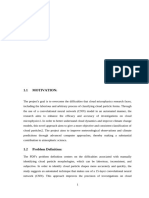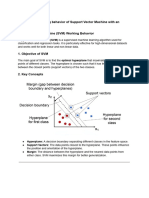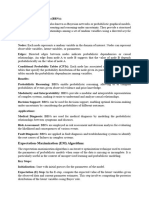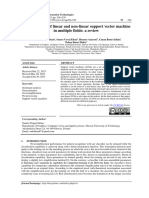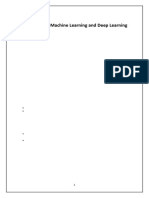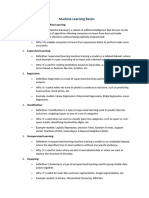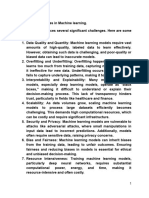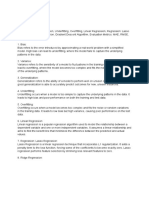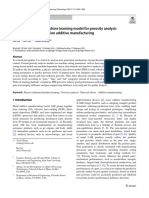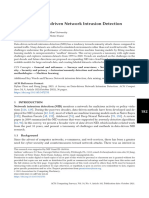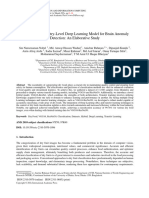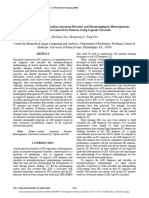ML Unit-4
ML Unit-4
Uploaded by
pavankumarvoore3Copyright:
Available Formats
ML Unit-4
ML Unit-4
Uploaded by
pavankumarvoore3Original Title
Copyright
Available Formats
Share this document
Did you find this document useful?
Is this content inappropriate?
Copyright:
Available Formats
ML Unit-4
ML Unit-4
Uploaded by
pavankumarvoore3Copyright:
Available Formats
2.
Parsimony: The MDL principle promotes parsimonious models that strike
a balance between complexity and explanatory power. It helps prevent
overfitting and improves generalization to new data.
3. Information-Theoretic Interpretation: The MDL principle has a solid
foundation in information theory and provides a clear interpretation based on
the lengths of the model description and data encoding.
4. Model Selection: MDL offers a rigorous and systematic approach to
model selection by providing a criterion that quantifies model complexity and
data fit.
The Minimum Description Length principle is a powerful concept in model
selection and inference. By combining principles of information theory and
coding, it provides a principled and effective way to balance model complexity
and data fit, leading to more reliable and interpretable models.
UNIT-IV
Support Vector Machines (SVM):
Support Vector Machines (SVM) is a popular and powerful supervised machine
learning algorithm used for classification and regression tasks. SVMs are
particularly effective in handling high-dimensional data and are known for their
ability to find complex decision boundaries.
The basic idea behind SVM is to find a hyperplane that best separates the data
points of different classes. A hyperplane in this context is a higher-dimensional
analogue of a line in 2D or a plane in 3D. The hyperplane should maximize the
margin between the closest data points of different classes, called support
Downloaded by Pavankumar Voore (pavankumarvoore3@gmail.com)
vectors. By maximizing the margin, SVM aims to achieve better generalization
and improved performance on unseen data.
Here are some key concepts and components of SVM:
1. Kernel Trick: SVM can handle both linearly separable and nonlinearly
separable data. The kernel trick allows SVM to implicitly map the input data
into a higher-dimensional feature space where the data may become linearly
separable. This is done without explicitly computing the coordinates of the data
points in the higher-dimensional space, thereby avoiding the computational cost.
2. Support Vectors: These are the data points that lie closest to the decision
boundary (hyperplane) and directly influence the position and orientation of the
hyperplane. These support vectors are crucial in determining the decision
boundary and are used during the classification of new data points.
3. Soft Margin: In cases where the data is not linearly separable, SVM
allows for a soft margin, where a few misclassifications or data points within
the margin are tolerated. This introduces a trade-off between maximizing the
margin and minimizing the classification error. The parameter controlling this
trade-off is called the regularization parameter (C).
4. Categorization: SVM can be used for both binary classification
(classifying data into two classes) and multiclass classification (classifying data
into more than two classes). For multiclass problems, SVMs can use either one-
vs-one or one-vs-all strategies to create multiple binary classifiers.
5. Regression: SVM can also be used for regression tasks by fitting a
hyperplane that approximates the target values. The goal is to minimize the
error between the predicted values and the actual target values.
6. Model Training and Optimization: SVM models are trained by solving a
quadratic optimization problem that aims to find the optimal hyperplane.
Various optimization algorithms, such as Sequential Minimal Optimization
Downloaded by Pavankumar Voore (pavankumarvoore3@gmail.com)
(SMO) or the widely used LIBSVM library, can be employed to efficiently
solve this problem.
SVMs have been widely used in various domains, including image
classification, text categorization, bioinformatics, and finance. They are
appreciated for their ability to handle high-dimensional data, robustness to
overfitting, and strong generalization performance.
However, SVMs can become computationally expensive and memory-intensive
when dealing with large datasets. Additionally, the choice of the kernel function
and its parameters can significantly impact the performance of the SVM model.
Proper tuning and selection of these parameters are essential for achieving
optimal results.
Overall, SVMs offer a versatile and effective approach to solving both
classification and regression problems, making them a valuable tool in the field
of machine learning.
Linear Discriminant Functions for Binary Classification
Linear Discriminant Functions (LDF), also known as Linear Discriminant
Analysis (LDA), is a classic supervised learning algorithm used for binary
classification. LDF aims to find a linear decision boundary that separates the
data points of different classes.
In LDF, the goal is to project the input data onto a lower-dimensional space in
such a way that the separation between classes is maximized. The algorithm
assumes that the data is normally distributed and that the covariance matrices of
the classes are equal. Based on these assumptions, LDF constructs linear
discriminant functions that assign class labels to new data points based on their
projected values.
Downloaded by Pavankumar Voore (pavankumarvoore3@gmail.com)
Here are the key steps involved in LDF for binary classification:
1. Data Preprocessing: LDF assumes that the data is normally distributed.
Therefore, it is often beneficial to apply standardization to the input features to
ensure that they have zero mean and unit variance. This step helps to eliminate
the influence of feature scales on the classification results.
2. Between-Class and Within-Class Scatter Matrices: LDF computes the
between-class scatter matrix and the within-class scatter matrix. The between-
class scatter matrix measures the spread between the class means, while the
within-class scatter matrix measures the spread within each class. These
matrices are used to determine the direction of the decision boundary.
3. Fisher's Criterion: Fisher's criterion is used to select the discriminant
functions that best separate the classes. It is calculated by taking the ratio of the
between-class scatter matrix to the within-class scatter matrix. Maximizing
Fisher's criterion leads to finding the optimal projection that maximizes class
separability.
4. Decision Boundary: LDF determines a threshold value to define the
decision boundary. New data points are assigned to the class whose discriminant
function value is greater than the threshold. The threshold is often set based on
the prior probabilities of the classes and can be adjusted to control the balance
between precision and recall.
5. Training and Classification: The LDF model is trained by estimating the
mean vectors and scatter matrices from the training data. The discriminant
functions are derived based on these estimates. To classify new data points, the
LDF computes the discriminant function values and assigns class labels based
on the decision boundary.
LDF has several advantages, including its simplicity, interpretability, and ability
to handle high-dimensional data. It is particularly useful when the class
Downloaded by Pavankumar Voore (pavankumarvoore3@gmail.com)
distributions are well-separated or when the number of samples is small
compared to the number of dimensions.
However, LDF assumes that the data is normally distributed and that the class
covariance matrices are equal. Violations of these assumptions can negatively
impact the performance of LDF. Additionally, LDF is a linear classifier and may
not perform well in cases where the decision boundary is nonlinear.
Overall, LDF is a useful technique for binary classification problems, providing
a straightforward and interpretable approach to separating classes based on
linear discriminant functions.
Perceptron Algorithm:
The Perceptron algorithm is a simple and widely used supervised learning
algorithm for binary classification. It is a type of linear classifier that learns a
decision boundary to separate the input data into two classes. The Perceptron
algorithm was one of the earliest forms of artificial neural networks and serves
as the foundation for more complex neural network architectures.
Here are the key steps involved in the Perceptron algorithm:
1. Initialization: Initialize the weights and bias of the perceptron to small
random values or zeros.
2. Training: Iterate through the training data instances until convergence or a
maximum number of iterations is reached. For each instance, follow these steps:
a. Compute the weighted sum of the input features and the corresponding
weights, and add the bias term.
b. Apply an activation function (typically a threshold function) to the weighted
sum to obtain the predicted output. For binary classification, the predicted
output can be either 0 or 1, representing the two classes.
Downloaded by Pavankumar Voore (pavankumarvoore3@gmail.com)
c. Compare the predicted output with the true class label of the instance and
calculate the prediction error.
d. Update the weights and bias based on the prediction error and the learning
rate. The learning rate determines the step size for adjusting the weights and can
impact the convergence speed and stability of the algorithm.
3. Convergence: The Perceptron algorithm continues iterating through the
training data until convergence is achieved or the maximum number of
iterations is reached. Convergence occurs when the algorithm correctly
classifies all the training instances or when the error falls below a predefined
threshold.
The Perceptron algorithm is often used for linearly separable data, where a
single hyperplane can accurately separate the two classes. However, it may not
converge or produce accurate results if the data is not linearly separable.
Extensions and variations of the Perceptron algorithm have been developed to
handle nonlinearly separable data. One such variation is the Multi-Layer
Perceptron (MLP), which consists of multiple layers of perceptrons
interconnected to form a neural network. The MLP uses activation functions
other than the threshold function and employs a process called backpropagation
to adjust the weights and biases of the network.
The Perceptron algorithm has some limitations. It is sensitive to the initial
weights and can converge to a local minimum rather than the global minimum.
It may also struggle with noisy or overlapping data. Additionally, the Perceptron
algorithm does not provide probabilistic outputs like some other classification
algorithms do.
Downloaded by Pavankumar Voore (pavankumarvoore3@gmail.com)
Despite these limitations, the Perceptron algorithm remains a fundamental and
powerful technique for binary classification tasks, especially in situations where
the data is linearly separable.
Large Margin Classifier for linearly seperable data
When dealing with linearly separable data, a Large Margin Classifier,
specifically the Support Vector Machine (SVM), can be employed to find an
optimal decision boundary that maximizes the margin between the classes.
SVM is well-suited for this task and provides a powerful way to handle binary
classification problems.
The SVM's objective is to find a hyperplane that separates the two classes with
the largest possible margin. The margin is the perpendicular distance between
the hyperplane and the closest data points from each class, also known as
support vectors. By maximizing this margin, SVM aims to achieve better
generalization and improved performance on unseen data.
Here's an overview of the steps involved in training an SVM for linearly
separable data:
1. Data Preprocessing: Ensure that the data is linearly separable by
transforming or scaling it, if necessary. SVM operates on numerical features, so
categorical variables may need to be encoded appropriately.
2. Formulation: In SVM, the problem is formulated as an optimization task
to find the hyperplane. The goal is to minimize the weights of the hyperplane
while satisfying the constraint that all data points are correctly classified. This
can be achieved by solving a convex quadratic programming problem.
Downloaded by Pavankumar Voore (pavankumarvoore3@gmail.com)
3. Margin Calculation: Compute the margin by measuring the perpendicular
distance from the hyperplane to the support vectors on both sides. The margin is
proportional to the inverse of the norm of the weight vector.
4. Optimization: Apply an optimization algorithm, such as Sequential
Minimal Optimization (SMO) or the LIBSVM library, to find the optimal
hyperplane that maximizes the margin.
5. Decision Boundary: The decision boundary is determined by the
hyperplane that separates the classes. New data points are classified based on
which side of the hyperplane they fall on.
SVMs have several advantages for linearly separable data:
SVMs find the optimal decision boundary that maximizes the margin,
leading to better generalization and improved robustness to noise.
The solution is unique and does not depend on the initial conditions.
SVMs can handle high-dimensional data efficiently using the kernel trick,
which implicitly maps the data to a higher-dimensional feature space.
However, it's worth noting that SVMs can become computationally expensive
and memory-intensive when dealing with large datasets. Additionally, the
choice of the kernel function and its parameters can significantly affect the
performance of the SVM model.
Overall, SVMs provide a powerful approach to building large margin classifiers
for linearly separable data, offering robustness and good generalization
properties.
Linear Soft Margin Classifier for Overlapping Classes
Downloaded by Pavankumar Voore (pavankumarvoore3@gmail.com)
When dealing with overlapping classes, a Linear Soft Margin Classifier, such as
the Soft Margin Support Vector Machine (SVM), can be used to handle the
misclassified or overlapping data points. The Soft Margin SVM allows for a
certain degree of misclassification by introducing a penalty for data points that
fall within the margin or are misclassified. This approach provides a balance
between maximizing the margin and minimizing the classification errors.
Here's an overview of the steps involved in training a Linear Soft Margin
Classifier:
1. Data Preprocessing: Ensure that the data is properly preprocessed,
including scaling and handling categorical variables, as necessary.
2. Formulation: The Soft Margin SVM aims to find a hyperplane that
separates the classes while allowing for some misclassifications. The problem is
formulated as an optimization task that minimizes the weights of the hyperplane
and the misclassification errors, along with a regularization term.
3. Margin Calculation: Compute the margin, which represents the distance
between the hyperplane and the support vectors. The Soft Margin SVM allows
for data points to fall within the margin or be misclassified. The margin is
proportional to the inverse of the norm of the weight vector.
4. Optimization: Apply an optimization algorithm, such as Sequential
Minimal Optimization (SMO) or the LIBSVM library, to find the optimal
hyperplane and weights that minimize the misclassification errors and maximize
the margin.
5. Decision Boundary: The decision boundary is determined by the
hyperplane that separates the classes. The Soft Margin SVM allows for some
misclassified or overlapping data points, so new data points are classified based
on which side of the hyperplane they fall on.
Downloaded by Pavankumar Voore (pavankumarvoore3@gmail.com)
The key difference between the Soft Margin SVM and the Hard Margin SVM
(for linearly separable data) lies in the regularization term and the tolerance for
misclassification. The Soft Margin SVM allows for a flexible decision boundary
that accommodates overlapping classes, while the Hard Margin SVM strictly
enforces a rigid decision boundary with no misclassifications.
It's important to note that the Soft Margin SVM introduces a trade-off
parameter, often denoted as C, which determines the balance between the
margin width and the misclassification errors. Higher values of C allow for
fewer misclassifications but may result in a narrower margin, while lower
values of C allow for a wider margin but may tolerate more misclassifications.
By using a Linear Soft Margin Classifier like the Soft Margin SVM, you can
handle overlapping classes by allowing for some degree of misclassification
while still aiming to maximize the margin as much as possible.
Kernel Induced Feature Spaces
Kernel-induced feature spaces, also known as the kernel trick, is a technique
used in machine learning, particularly in algorithms like Support Vector
Machines (SVMs), to implicitly transform the input data into higher-
dimensional feature spaces without explicitly calculating the transformed
feature vectors. The kernel trick allows linear classifiers to effectively handle
nonlinear relationships between the input features by projecting the data into a
higher-dimensional space where it might become linearly separable.
Here's how kernel-induced feature spaces work:
1. Linear Separability Challenge: In some cases, the data may not be
linearly separable in the original feature space. For example, a simple linear
Downloaded by Pavankumar Voore (pavankumarvoore3@gmail.com)
classifier like SVM may struggle to find a linear decision boundary that
separates classes when they are intertwined or nonlinearly related.
2. Kernel Function: A kernel function is defined, which takes two input
feature vectors and computes their similarity or inner product in the higher-
dimensional feature space. The choice of kernel function depends on the
problem and data characteristics. Popular kernel functions include the linear
kernel, polynomial kernel, Gaussian (RBF) kernel, and sigmoid kernel.
3. Implicit Transformation: Instead of explicitly computing the transformed
feature vectors, the kernel function implicitly calculates the similarity or inner
product of the data points in the higher-dimensional space. The kernel trick
avoids the computational cost of explicitly transforming the data while still
leveraging the benefits of operating in a higher-dimensional feature space.
4. Linear Classifier in the Transformed Space: In the higher-dimensional
feature space, a linear classifier like SVM can find a hyperplane that effectively
separates the classes. Although the classifier operates in this transformed space,
the decision boundary can be expressed in terms of the original input feature
space through the kernel function.
5. Prediction and Classification: To classify new data points, the kernel
function is used to compute their similarity or inner product with the support
vectors in the transformed space. The decision is made based on the sign of the
computed value, which indicates the class to which the new data point belongs.
The kernel trick is powerful as it allows linear classifiers to capture complex,
nonlinear relationships between the data points by implicitly operating in
higher-dimensional spaces. By choosing an appropriate kernel function, the data
can be effectively transformed into a space where linear separability is
achieved, even if it was not possible in the original feature space.
Downloaded by Pavankumar Voore (pavankumarvoore3@gmail.com)
The kernel trick is not limited to SVMs but can be applied in various algorithms
and tasks where nonlinearity needs to be captured. It has been successfully used
in image recognition, text analysis, bioinformatics, and other fields where
complex patterns and relationships exist in the data.
The kernel trick provides a flexible and computationally efficient way to handle
nonlinear data and is a valuable tool for enhancing the capabilities of linear
classifiers in machine learning.
Nonlinear Classifier:
A nonlinear classifier is a machine learning algorithm that can capture and
model nonlinear relationships between input features and target variables.
Unlike linear classifiers, which assume a linear decision boundary, nonlinear
classifiers can handle complex patterns and dependencies in the data.
There are several types of nonlinear classifiers commonly used in machine
learning:
1. Decision Trees: Decision trees are a versatile nonlinear classifier that
recursively splits the data based on feature values to create a hierarchical
structure of decisions. They can capture complex nonlinear relationships by
forming nonlinear decision boundaries through a combination of linear
segments.
2. Random Forests: Random forests are an ensemble of decision trees. They
combine multiple decision trees to make predictions by averaging or voting. By
leveraging the diversity of decision trees, random forests can handle complex
nonlinear relationships and improve generalization performance.
3. Neural Networks: Neural networks are highly flexible and powerful
nonlinear classifiers inspired by the structure and function of the human brain.
Downloaded by Pavankumar Voore (pavankumarvoore3@gmail.com)
They consist of interconnected layers of artificial neurons (nodes) that process
and transform data through nonlinear activation functions. Neural networks can
model complex and hierarchical patterns, making them effective for capturing
nonlinear relationships.
4. Support Vector Machines with Kernels: Support Vector Machines
(SVMs) can be enhanced with kernel functions to create nonlinear classifiers.
The kernel trick allows SVMs to implicitly map the input data into a higher-
dimensional feature space where the data may become linearly separable. This
enables SVMs to capture nonlinear decision boundaries.
5. Gaussian Processes: Gaussian processes are probabilistic models that can
be used as nonlinear classifiers. They model the underlying distribution of the
data points and make predictions based on the learned distribution. Gaussian
processes can handle complex and flexible nonlinear relationships and provide
uncertainty estimates for predictions.
6. k-Nearest Neighbors (k-NN): The k-NN algorithm classifies data points
based on the class labels of their nearest neighbors. It can capture nonlinear
relationships by considering the local structure of the data. By adjusting the
value of k, the k-NN classifier can adapt to different levels of nonlinear
complexity.
These are just a few examples of popular nonlinear classifiers. Other algorithms
like Naive Bayes, gradient boosting machines, and kernel-based methods like
radial basis function networks are also effective in capturing nonlinear
relationships.
Nonlinear classifiers offer the advantage of increased flexibility and the ability
to model complex relationships in the data. However, they may require more
computational resources and can be more prone to overfitting compared to
linear classifiers. Proper model selection, feature engineering, and
Downloaded by Pavankumar Voore (pavankumarvoore3@gmail.com)
regularization techniques are crucial when working with nonlinear classifiers to
ensure optimal performance and generalization.
Regression by Support vector Machines:
Support Vector Machines (SVM) can also be used for regression tasks in
addition to classification. The regression variant of SVM is known as Support
Vector Regression (SVR). SVR aims to find a regression function that predicts
continuous target variables rather than discrete class labels.
Here's an overview of how SVR works:
1. Data Representation: Like in classification, SVR requires a training
dataset with input features and corresponding target values. The target values
should be continuous and represent the quantity to be predicted.
2. Formulation: SVR formulates the regression problem as an optimization
task. The goal is to find a regression function that maximizes the margin around
the predicted values while keeping the prediction errors within a specified
tolerance level. The margin in SVR refers to the distance between the regression
function and the closest training points.
3. Kernel Trick: SVR can leverage the kernel trick, similar to its
classification counterpart, to handle nonlinear relationships between the input
features and target variables. The kernel function implicitly maps the data into a
higher-dimensional feature space, allowing for nonlinear regression.
4. Regularization Parameter and Tolerance: SVR introduces a regularization
parameter, often denoted as C, which controls the trade-off between the margin
width and the amount of allowable prediction errors. A smaller C allows for
larger errors, while a larger C enforces a smaller margin and fewer errors.
5. Loss Function: SVR uses a loss function that penalizes the prediction
errors beyond a certain threshold called the epsilon (ε). Errors within the epsilon
Downloaded by Pavankumar Voore (pavankumarvoore3@gmail.com)
tube are considered negligible and do not contribute to the loss. Errors outside
the epsilon tube are included in the loss calculation, and the objective is to
minimize their magnitude.
6. Model Training and Prediction: The SVR model is trained by optimizing
the regression function parameters to minimize the loss function. The training
involves solving a convex quadratic optimization problem. Once trained, the
SVR model can be used to predict target values for new data points.
SVR offers several benefits for regression tasks:
Flexibility: SVR can capture complex and nonlinear relationships
between the input features and target variables by using different kernel
functions.
Robustness: The use of the margin and epsilon tube helps SVR to handle
outliers and noisy data points, making it robust against noise.
Generalization: SVR aims to find a regression function with good
generalization properties, allowing it to make accurate predictions on unseen
data.
However, similar to SVM for classification, SVR has some considerations:
Kernel Selection: Choosing an appropriate kernel function is important
for achieving optimal performance in SVR. Different kernel functions have
different characteristics and are suitable for different types of data.
Hyperparameter Tuning: The regularization parameter (C) and the width
of the epsilon tube (ε) need to be properly tuned to balance the trade-off
between margin width and error tolerance.
Computational Complexity: SVR can be computationally expensive,
especially when using nonlinear kernels or dealing with large datasets.
Downloaded by Pavankumar Voore (pavankumarvoore3@gmail.com)
Overall, Support Vector Regression (SVR) provides a powerful approach for
regression tasks by finding a regression function that maximizes the margin
around the predicted values. It offers flexibility, robustness, and good
generalization properties when dealing with continuous target variables.
Learning with Neural Networks:
Learning with neural networks is a widely used and powerful approach in
machine learning and artificial intelligence. Neural networks, also known as
artificial neural networks or deep learning models, are inspired by the structure
and functioning of the human brain. They consist of interconnected nodes
(neurons) organized in layers, allowing them to learn and extract meaningful
representations from complex data.
Here's an overview of the key components and steps involved in learning with
neural networks:
1. Architecture: The architecture of a neural network defines its structure
and organization. It consists of input layers, hidden layers, and an output layer.
The number of hidden layers and the number of neurons in each layer can vary
depending on the complexity of the problem and the available data.
2. Activation Function: Each neuron applies an activation function to the
weighted sum of its inputs. The activation function introduces nonlinearity into
the network, enabling it to learn complex relationships and capture nonlinear
patterns in the data. Common activation functions include sigmoid, ReLU
(Rectified Linear Unit), and tanh.
3. Feedforward Propagation: The input data is fed forward through the
network in a process called feedforward propagation. Each neuron in a layer
receives input from the previous layer, applies the activation function, and
Downloaded by Pavankumar Voore (pavankumarvoore3@gmail.com)
passes the output to the next layer until reaching the output layer. This process
generates predictions or outputs from the network.
4. Loss Function: A loss function measures the discrepancy between the
predicted outputs of the network and the true labels or target values. The choice
of the loss function depends on the problem type, such as mean squared error
(MSE) for regression tasks or cross-entropy loss for classification tasks.
5. Backpropagation: Backpropagation is a key algorithm used to train neural
networks. It involves computing the gradient of the loss function with respect to
the weights and biases of the network, and then using this gradient to update the
weights and biases via gradient descent or other optimization techniques. The
process is repeated iteratively, adjusting the weights and biases to minimize the
loss function and improve the network's predictions.
6. Training and Validation: The neural network is trained using a labeled
dataset, where the input features are paired with corresponding target values or
labels. The data is divided into training and validation sets. The training set is
used to update the network's parameters through backpropagation, while the
validation set helps monitor the network's performance and prevent overfitting.
Regularization techniques, such as dropout or weight decay, can be applied to
avoid overfitting.
7. Hyperparameter Tuning: Neural networks have several hyperparameters,
such as the learning rate, number of layers, number of neurons, activation
functions, and regularization parameters. Fine-tuning these hyperparameters is
essential to achieve optimal network performance. This can be done through
techniques like grid search or random search.
8. Prediction and Inference: Once the neural network is trained, it can be
used to make predictions or perform inference on new, unseen data. The input
data is propagated through the network, and the final output layer provides the
predicted values or class probabilities.
Downloaded by Pavankumar Voore (pavankumarvoore3@gmail.com)
Neural networks excel at learning complex representations and extracting
patterns from large amounts of data. They have achieved significant success in
various domains, including image recognition, natural language processing,
speech recognition, and recommendation systems.
However, neural networks can be computationally expensive, require substantial
amounts of training data, and demand careful tuning of hyperparameters.
Additionally, overfitting can be a challenge, and the interpretability of neural
network models can be limited due to their complex nature.
Overall, learning with neural networks provides a powerful and versatile
approach to tackle a wide range of machine learning tasks, enabling the
development of highly accurate and sophisticated models.
Towards Cognitive Machine:
Towards achieving cognitive machines, researchers and practitioners are
exploring the development of machine learning systems that can emulate
human-like cognitive abilities. Cognitive machines aim to go beyond traditional
machine learning approaches by incorporating advanced capabilities such as
perception, reasoning, learning, and decision-making, similar to human
cognition.
Here are some key areas of focus in the development of cognitive machines:
1. Perception: Cognitive machines should be capable of perceiving and
interpreting sensory data from various modalities, including vision, speech, and
text. This involves tasks such as object recognition, speech recognition, natural
language understanding, and sentiment analysis.
2. Reasoning and Knowledge Representation: Cognitive machines need the
ability to reason, understand complex relationships, and represent knowledge in
Downloaded by Pavankumar Voore (pavankumarvoore3@gmail.com)
a structured manner. This includes tasks such as logical reasoning, semantic
understanding, knowledge graph construction, and inference.
3. Learning and Adaptation: Cognitive machines should possess the ability
to learn from data, update their knowledge, and adapt to new information and
changing environments. This includes both supervised and unsupervised
learning techniques, reinforcement learning, transfer learning, and lifelong
learning.
4. Context Awareness: Cognitive machines should be aware of the context
in which they operate. They should understand and consider factors such as
time, location, user preferences, and social dynamics to make intelligent and
contextually appropriate decisions.
5. Decision-Making and Planning: Cognitive machines should be capable of
making autonomous decisions and planning actions based on their
understanding of the world and their goals. This involves techniques such as
decision theory, optimization, and automated planning.
6. Explainability and Interpretability: To instill trust and facilitate human-
machine collaboration, cognitive machines should be able to provide
explanations and justifications for their decisions and actions. Research in
explainable AI (XAI) aims to make the reasoning processes of cognitive
machines transparent and interpretable.
7. Interaction and Communication: Cognitive machines should be able to
interact with humans and other machines in natural and intuitive ways. This
includes natural language generation, dialogue systems, human-computer
interfaces, and multimodal interaction.
8. Ethical and Responsible AI: The development of cognitive machines
should consider ethical considerations, fairness, transparency, and
accountability. Ensuring that these machines adhere to societal norms and
values is crucial for their responsible deployment.
Downloaded by Pavankumar Voore (pavankumarvoore3@gmail.com)
Advancing towards cognitive machines is a complex and multidisciplinary
endeavor, drawing from fields such as artificial intelligence, cognitive science,
neuroscience, and philosophy. While significant progress has been made, there
are still many challenges to overcome to achieve truly cognitive machines that
can exhibit human-like cognition across a wide range of tasks and domains.
Neuron Models:
Neuron models are mathematical or computational representations of individual
neurons, which are the basic building blocks of neural networks and the primary
components of the brain's information processing system. Neuron models aim to
capture the behavior and functionality of biological neurons, enabling the
simulation and understanding of neural processes in artificial systems.
Here are a few commonly used neuron models:
1. McCulloch-Pitts Neuron Model: The McCulloch-Pitts model, also known
as the threshold logic unit, is one of the earliest neuron models. It represents a
binary threshold neuron that receives input signals, applies a weighted sum to
them, and outputs a binary response based on whether the sum exceeds a
predefined threshold. This model forms the foundation of modern artificial
neural networks.
2. Perceptron Neuron Model: The perceptron is an extension of the
McCulloch-Pitts model. It includes an additional activation function, typically a
step function, that maps the weighted sum of inputs to an output. The perceptron
can learn binary linear classifiers and has played a significant role in the
development of neural network models.
3. Sigmoid Neuron Model: The sigmoid neuron model uses a sigmoid
activation function, such as the logistic function or hyperbolic tangent function.
This allows for continuous outputs and smooth gradients, enabling the use of
Downloaded by Pavankumar Voore (pavankumarvoore3@gmail.com)
gradient-based optimization algorithms for training neural networks. Sigmoid
neurons are often used in multilayer perceptrons (MLPs).
4. Spiking Neuron Model: Spiking neuron models capture the spiking
behavior observed in biological neurons. Instead of representing continuous
activations, these models simulate the discrete firing of action potentials
(spikes). Spiking neuron models, such as the Hodgkin-Huxley model or
integrate-and-fire models, are useful for studying neural dynamics and complex
temporal processing.
5. Leaky Integrate-and-Fire Neuron Model: The leaky integrate-and-fire
model is a simplified spiking neuron model that simulates the integration of
incoming inputs over time. It accumulates input currents until reaching a
threshold, at which point it emits a spike and resets the membrane potential. The
leaky integrate-and-fire model is computationally efficient and widely used in
simulations.
6. Rectified Linear Unit (ReLU) Neuron Model: The ReLU neuron model
has gained popularity in recent years. It applies a rectification function to the
weighted sum of inputs, resulting in a piecewise linear activation that is more
biologically plausible than sigmoidal activations. ReLU neurons have been
instrumental in deep learning architectures due to their simplicity and
computational efficiency.
These are just a few examples of neuron models used in artificial neural
networks. Neuron models vary in complexity and purpose, ranging from simple
binary units to more biologically inspired spiking models. The choice of neuron
model depends on the specific application, the desired behavior, and the level of
biological fidelity required.
Network Architectures:
Downloaded by Pavankumar Voore (pavankumarvoore3@gmail.com)
Network architectures refer to the organization and structure of artificial neural
networks, determining how neurons are connected and how information flows
within the network. Different network architectures are designed to address
specific tasks, model complex relationships, and achieve optimal performance
in various machine learning applications. Here are some commonly used
network architectures:
1. Feedforward Neural Networks (FNNs): FNNs are the simplest and most
basic type of neural network architecture. They consist of an input layer, one or
more hidden layers, and an output layer. Information flows only in one
direction, from the input layer through the hidden layers to the output layer.
FNNs are widely used for tasks like classification, regression, and pattern
recognition.
2. Convolutional Neural Networks (CNNs): CNNs are particularly effective
for image and video processing tasks. They utilize convolutional layers that
apply filters to input data, enabling the extraction of local features and patterns.
CNNs employ pooling layers to downsample the data and reduce spatial
dimensions, followed by fully connected layers for classification or regression.
CNNs excel in tasks such as image recognition, object detection, and image
segmentation.
3. Recurrent Neural Networks (RNNs): RNNs are designed to handle
sequential and time-series data. They include recurrent connections that allow
information to flow in loops, enabling the network to maintain memory of past
inputs. This makes RNNs suitable for tasks such as natural language processing,
speech recognition, and sentiment analysis. Long Short-Term Memory (LSTM)
and Gated Recurrent Unit (GRU) are popular variants of RNNs that address the
vanishing gradient problem.
4. Generative Adversarial Networks (GANs): GANs consist of two neural
networks, a generator and a discriminator, competing against each other in a
Downloaded by Pavankumar Voore (pavankumarvoore3@gmail.com)
game-like setting. The generator generates synthetic data, while the
discriminator learns to distinguish between real and synthetic data. GANs are
widely used for tasks like image synthesis, data generation, and unsupervised
learning.
5. Autoencoders: Autoencoders are unsupervised neural networks that aim
to learn efficient representations of input data. They consist of an encoder that
compresses the input data into a lower-dimensional latent space and a decoder
that reconstructs the original input from the latent representation. Autoencoders
are used for tasks such as dimensionality reduction, anomaly detection, and
image denoising.
6. Transformer Networks: Transformer networks have gained popularity in
natural language processing tasks, especially in machine translation and
language generation. They rely on self-attention mechanisms to capture global
dependencies between input and output sequences, enabling parallel processing
and effective modeling of long-range dependencies.
7. Deep Reinforcement Learning Networks: Deep reinforcement learning
networks combine deep neural networks with reinforcement learning
algorithms. They are used in applications where an agent learns to make
sequential decisions by interacting with an environment. Deep reinforcement
learning networks have achieved remarkable success in domains such as game
playing, robotics, and autonomous systems.
These are just a few examples of network architectures used in neural networks.
Various variations and combinations of these architectures, along with new
ones, continue to be developed to tackle specific challenges and improve
performance in different domains. The choice of architecture depends on the
nature of the problem, the available data, and the desired outputs.
Perceptrons
Downloaded by Pavankumar Voore (pavankumarvoore3@gmail.com)
Perceptrons are one of the earliest and simplest forms of artificial neural
networks. They are binary classifiers that make decisions based on a weighted
sum of input features and a threshold value. Perceptrons were introduced by
Frank Rosenblatt in the late 1950s and played a crucial role in the development
of neural network models.
Here's an overview of perceptrons and how they work:
1. Neuron Structure: A perceptron consists of a single neuron or node. Each
neuron has input connections, weights associated with those connections, and an
activation function.
2. Input Features: Perceptrons receive input features, typically represented
as a feature vector. Each feature is multiplied by its corresponding weight, and
the results are summed up.
3. Activation Function: The summed result is then passed through an
activation function, often a step function or a threshold function. The activation
function compares the weighted sum to a predefined threshold value and
determines the output of the perceptron, usually binary (0 or 1).
4. Training: Perceptrons are trained using a supervised learning algorithm
called the perceptron learning rule or the delta rule. The learning rule adjusts the
weights based on the error between the predicted output and the true output. The
goal is to update the weights iteratively until the perceptron correctly classifies
the training data.
5. Decision Boundary: The weights and the threshold of a perceptron define
a decision boundary. For a perceptron with two input features, the decision
boundary is a line in a two-dimensional space. In higher dimensions, the
decision boundary can be a hyperplane.
Perceptrons are limited to linearly separable problems. They can only classify
data that can be perfectly separated by a linear decision boundary. If the data is
Downloaded by Pavankumar Voore (pavankumarvoore3@gmail.com)
not linearly separable, perceptrons may not converge or may produce incorrect
results.
However, perceptrons can be combined to form multilayer perceptrons (MLPs)
with multiple layers of neurons, allowing them to capture more complex
relationships and handle non-linearly separable problems. MLPs, with the use of
activation functions such as sigmoid or ReLU, can approximate any function
given enough neurons and proper training.
Historically, perceptrons had limitations that led to a decline in interest in neural
networks. However, they remain fundamental to the field and have laid the
groundwork for more advanced and powerful neural network architectures that
we use today.
Linear neuron and the Widrow-Hoff Learning Rule
The linear neuron, also known as the single-layer perceptron, is a simplified
form of a neural network that uses a linear activation function. It is a type of
feedforward neural network that can be trained to perform binary classification
tasks.
The Widrow-Hoff learning rule, also known as the delta rule or the LMS (Least
Mean Squares) rule, is an algorithm used to train linear neurons. It adjusts the
weights of the neuron based on the error between the predicted output and the
true output, aiming to minimize the mean squared error.
Here's how the linear neuron and the Widrow-Hoff learning rule work:
1. Neuron Structure: The linear neuron has input connections, each
associated with a weight, and a bias term. The weighted sum of the inputs,
including the bias term, is calculated.
Downloaded by Pavankumar Voore (pavankumarvoore3@gmail.com)
2. Linear Activation Function: The linear activation function simply outputs
the weighted sum of the inputs without applying any nonlinearity. It is
represented as f(x) = x.
3. Training Data: The training data consists of input feature vectors and
corresponding target values (class labels or continuous values).
4. Initialization: The weights and the bias of the linear neuron are initialized
with small random values or zeros.
5. Forward Propagation: The input feature vectors are fed into the linear
neuron, and the weighted sum is computed.
6. Error Calculation: The error is calculated by comparing the predicted
output with the true target value. For binary classification, the error can be
computed as the difference between the predicted output and the target class
label. For regression tasks, the error is the difference between the predicted
output and the target continuous value.
7. Weight Update: The Widrow-Hoff learning rule updates the weights and
the bias term of the linear neuron based on the error. The weights are adjusted
proportionally to the input values and the error. The learning rule uses a learning
rate parameter to control the step size of the weight updates.
8. Iterative Training: The weight updates are performed iteratively, repeating
the process of forward propagation, error calculation, and weight update for the
entire training dataset. The goal is to minimize the mean squared error by
adjusting the weights.
9. Convergence: The learning process continues until the mean squared
error falls below a predefined threshold or reaches a maximum number of
iterations.
The linear neuron with the Widrow-Hoff learning rule is limited to linearly
separable problems. If the data is not linearly separable, the linear neuron may
not be able to converge to a satisfactory solution. In such cases, more advanced
Downloaded by Pavankumar Voore (pavankumarvoore3@gmail.com)
architectures like multilayer perceptrons (MLPs) with nonlinear activation
functions are used.
The Widrow-Hoff learning rule provides a simple and efficient algorithm for
training linear neurons. While it has limitations in handling nonlinear problems,
it serves as the foundation for more sophisticated learning algorithms used in
neural networks.
The error correction delta rule:
The error correction delta rule, also known as the delta rule or the delta learning
rule, is a learning algorithm used to train single-layer neural networks, such as
linear neurons or single-layer perceptrons. It is a simple and widely used
algorithm for binary classification tasks.
Here's how the error correction delta rule works:
1. Neuron Structure: The neural network consists of a single layer of
neurons with input connections, each associated with a weight, and a bias term.
The weighted sum of the inputs, including the bias term, is calculated.
2. Activation Function: The activation function used in the error correction
delta rule is typically a step function. It assigns an output of 1 if the weighted
sum of inputs exceeds a threshold value, and 0 otherwise.
3. Training Data: The training data consists of input feature vectors and
corresponding target class labels.
4. Initialization: The weights and the bias of the neuron are initialized with
small random values or zeros.
5. Forward Propagation: The input feature vectors are fed into the neuron,
and the weighted sum is computed.
Downloaded by Pavankumar Voore (pavankumarvoore3@gmail.com)
6. Error Calculation: The error is calculated by subtracting the predicted
output from the true target class label. The error represents the discrepancy
between the predicted output and the desired output.
7. Weight Update: The weight update is performed based on the error and
the input values. The weight update is proportional to the error and the input
value. The learning rule uses a learning rate parameter to control the step size of
the weight updates.
8. Bias Update: The bias term can also be updated based on a similar
principle, with the bias update being proportional to the error and a constant
value (often 1).
9. Iterative Training: The weight and bias updates are performed iteratively,
repeating the process of forward propagation, error calculation, weight update,
and bias update for the entire training dataset.
10. Convergence: The learning process continues until the neural network
correctly classifies all the training examples or reaches a maximum number of
iterations.
The error correction delta rule is primarily suitable for linearly separable
problems. For problems that are not linearly separable, it may not converge or
produce accurate results. In such cases, more advanced architectures like
multilayer perceptrons (MLPs) with nonlinear activation functions and more
sophisticated learning algorithms, such as backpropagation, are used.
Downloaded by Pavankumar Voore (pavankumarvoore3@gmail.com)
You might also like
- Driver Drowsiness Detection System Using Artificial IntelligenceDocument26 pagesDriver Drowsiness Detection System Using Artificial IntelligenceDona feble p jNo ratings yet
- Unvilling - Shapes - PDocument46 pagesUnvilling - Shapes - Plavanyaprakash JampanaNo ratings yet
- SVMDocument9 pagesSVMsuleymanabdu0931No ratings yet
- Machine Learning AlgorithmsDocument13 pagesMachine Learning AlgorithmsMSC NFCNo ratings yet
- Support Vector Machine (SVM)Document5 pagesSupport Vector Machine (SVM)KkNo ratings yet
- UNIT 2 - NotesDocument31 pagesUNIT 2 - Notes126Monish BNo ratings yet
- Machine Learning MidtermDocument18 pagesMachine Learning MidtermserialkillerseeyouNo ratings yet
- Unit 2Document7 pagesUnit 221csme011anayNo ratings yet
- AI LAB Assignment 10Document4 pagesAI LAB Assignment 10yash.singh.btech2021No ratings yet
- SVM PresentationDocument27 pagesSVM Presentationneeraj12121No ratings yet
- Unit 5Document11 pagesUnit 5Md. SunmunNo ratings yet
- A Review of Supervised Learning Based Classification For Text To Speech SystemDocument8 pagesA Review of Supervised Learning Based Classification For Text To Speech SystemInternational Journal of Application or Innovation in Engineering & ManagementNo ratings yet
- Machine Unit4Document55 pagesMachine Unit4AshNo ratings yet
- Machine Learning Algorithms For Breast Cancer PredictionDocument8 pagesMachine Learning Algorithms For Breast Cancer PredictionVartika AnandNo ratings yet
- ML Mod 4Document13 pagesML Mod 4neha1831sewaniNo ratings yet
- Support Vector Machine (SVM) : Basic TerminologiesDocument2 pagesSupport Vector Machine (SVM) : Basic Terminologiesrohitkumar2021No ratings yet
- Classification Algorithms 3rdDocument15 pagesClassification Algorithms 3rdrajishere12345No ratings yet
- Wa0000.Document26 pagesWa0000.Lakkarsu PoojithaNo ratings yet
- Generalization of Linear and Non-Linear Support Vector Machine in Multiple Fields: A ReviewDocument14 pagesGeneralization of Linear and Non-Linear Support Vector Machine in Multiple Fields: A ReviewCSIT iaesprimeNo ratings yet
- NLP Review Classfication: Knowledge Solutions IndiaDocument11 pagesNLP Review Classfication: Knowledge Solutions IndiaSavita GirigoudarNo ratings yet
- machine learning note 3Document2 pagesmachine learning note 3fengsijie360No ratings yet
- PaperDocument6 pagesPaperZulkifal A ràjaNo ratings yet
- Unit 1Document15 pagesUnit 1Lavanya VenkataNo ratings yet
- 3.unit 3 ML Part-1 Q&ADocument39 pages3.unit 3 ML Part-1 Q&Ashaik amreenNo ratings yet
- Support Vector Machine DissertationDocument7 pagesSupport Vector Machine DissertationProfessionalCollegePaperWritersMcAllen100% (1)
- ML FundamentalsDocument15 pagesML FundamentalsSam SmithNo ratings yet
- AssignmentDocument5 pagesAssignmentvenomfate778No ratings yet
- Assignment 2Document111 pagesAssignment 2BWENGYE JUSTUSNo ratings yet
- Machine Learning NotesDocument64 pagesMachine Learning Notesv.saigeetha lakshmiNo ratings yet
- Machine Learning QsDocument10 pagesMachine Learning QsonkarxoNo ratings yet
- Support Vector Machine - TheoryDocument8 pagesSupport Vector Machine - TheoryV. Ganesh KarthikeyanNo ratings yet
- Machine Learning BasicsDocument32 pagesMachine Learning Basicsanutoshtiwari2002No ratings yet
- Machine Learning QNADocument1 pageMachine Learning QNApratikmovie999No ratings yet
- Machine LearningDocument15 pagesMachine Learningonlygods061No ratings yet
- Data CollectionDocument8 pagesData CollectionsowmiNo ratings yet
- Machine Learning BasicsDocument5 pagesMachine Learning Basicssahil fuckNo ratings yet
- Unit2 notes What is a Support Vector MachineDocument11 pagesUnit2 notes What is a Support Vector Machinesonia choudharyNo ratings yet
- unit 4 MLDocument24 pagesunit 4 MLrachit.gaming.1410No ratings yet
- ML finalDocument92 pagesML finalhamzaplayhtNo ratings yet
- Data Science NotesDocument36 pagesData Science Notesmdluffyyy300No ratings yet
- Ann Unit IIIDocument20 pagesAnn Unit IIIChandiran SNo ratings yet
- Machine Learning (Part 1) : Iykra Data Fellowship Batch 3Document28 pagesMachine Learning (Part 1) : Iykra Data Fellowship Batch 3aril danNo ratings yet
- Unit6 002Document10 pagesUnit6 002Uday SinghNo ratings yet
- DS - UNIT - III - QB & AnsDocument25 pagesDS - UNIT - III - QB & Anssarangrao2304No ratings yet
- ML Viva QuestionsDocument4 pagesML Viva QuestionsRishu SinghNo ratings yet
- Information Retrieval Important questionsDocument20 pagesInformation Retrieval Important questionshamzaplayhtNo ratings yet
- Why Use PCADocument85 pagesWhy Use PCAProfessorNo ratings yet
- Machine Learning ToolboxDocument10 pagesMachine Learning ToolboxmlaijNo ratings yet
- Support Vector MachineDocument14 pagesSupport Vector MachinetrendysyncsNo ratings yet
- A) What Is Motivation Behind Ensemble Methods? Give Your Answer in Probabilistic TermsDocument6 pagesA) What Is Motivation Behind Ensemble Methods? Give Your Answer in Probabilistic TermsHassan Saddiqui100% (1)
- Machine Learning Term Test 2Document20 pagesMachine Learning Term Test 2CS23PANKARSAIRAJNo ratings yet
- Machine Learning Section4 Ebook v03Document20 pagesMachine Learning Section4 Ebook v03camgovaNo ratings yet
- Practical # 11Document10 pagesPractical # 11Alishba AleemNo ratings yet
- Support Vecor MachineDocument4 pagesSupport Vecor Machineyashnath405No ratings yet
- Common DS Interview Questions and Answers - 2Document7 pagesCommon DS Interview Questions and Answers - 2pablo.villegas.millsNo ratings yet
- Unit-1 DLDocument29 pagesUnit-1 DLIndrajeet KumarNo ratings yet
- ML Questions Answer Q1Document79 pagesML Questions Answer Q1cmdeptNo ratings yet
- Interview questions companieDocument72 pagesInterview questions companiey6bt250No ratings yet
- Interview QuestionsDocument67 pagesInterview Questionsvaishnav Jyothi100% (1)
- M.L. 3,5,6 Unit 3Document6 pagesM.L. 3,5,6 Unit 3atharv moreNo ratings yet
- Application of Machine Learning in Chemical Engineering: Outlook and PerspectivesDocument12 pagesApplication of Machine Learning in Chemical Engineering: Outlook and PerspectivesIAES IJAINo ratings yet
- A Novel Study For The Use of E-Learning Tools in Teaching and LearningDocument10 pagesA Novel Study For The Use of E-Learning Tools in Teaching and LearningCentral Asian StudiesNo ratings yet
- NBA Game Prediction Using Machine Learning AlgorithmDocument6 pagesNBA Game Prediction Using Machine Learning Algorithmayesha awanNo ratings yet
- 6 - Steps of The Classification Algorithm in Supervised LearningDocument15 pages6 - Steps of The Classification Algorithm in Supervised LearningRajendra ChadalawadaNo ratings yet
- Face RecognitionDocument92 pagesFace Recognitionchaithra580100% (1)
- Threat Detection Model Based On MachineDocument5 pagesThreat Detection Model Based On MachineShehara FernandoNo ratings yet
- A Physics-Informed Machine Learning Model For Porosity AnalysisDocument16 pagesA Physics-Informed Machine Learning Model For Porosity AnalysisDileep GangwarNo ratings yet
- Novel Graph-Based Machine Learning Technique To Secure Smart Vehicles in Intelligent Transportation SystemsDocument9 pagesNovel Graph-Based Machine Learning Technique To Secure Smart Vehicles in Intelligent Transportation Systemscnabhilash2No ratings yet
- Comprehensive Review On Clustering Techniques and Its Application On High Dimensional DataDocument8 pagesComprehensive Review On Clustering Techniques and Its Application On High Dimensional DataIhsen IbNo ratings yet
- Sign Language TranslationDocument23 pagesSign Language Translation陳子彤No ratings yet
- Human Activities Classifier Using SVMDocument19 pagesHuman Activities Classifier Using SVMBsef19m012-IQRA SARWARNo ratings yet
- 4 - Patch SVDD Patch-Level SVDD For Anomaly Detection and SegmentationDocument22 pages4 - Patch SVDD Patch-Level SVDD For Anomaly Detection and Segmentationfarzad imanpourNo ratings yet
- Cie 2Document13 pagesCie 2tarunbinjadagi18No ratings yet
- Report Practical PRDocument13 pagesReport Practical PRpaul sakelaridisNo ratings yet
- Wasserstein Generative Adversarial Networks For Bacterial Hemoglobin-Like Proteins PredictionDocument18 pagesWasserstein Generative Adversarial Networks For Bacterial Hemoglobin-Like Proteins PredictionijbbjournalNo ratings yet
- Deep Learning QuantumDocument124 pagesDeep Learning Quantumdhruvgautam380No ratings yet
- (Chou e JIANG) A Survey On Data-Driven Network Intrusion Detection.Document36 pages(Chou e JIANG) A Survey On Data-Driven Network Intrusion Detection.augustosantos1986No ratings yet
- Deep Learning - A Gentle IntroductionDocument100 pagesDeep Learning - A Gentle IntroductionJulian I SwandiNo ratings yet
- Instant Download An Introduction to Statistical Learning: with Applications in Python Gareth James PDF All ChaptersDocument50 pagesInstant Download An Introduction to Statistical Learning: with Applications in Python Gareth James PDF All Chaptersbxbyyoyer100% (3)
- 1 s2.0 S1568494614001823 MainDocument10 pages1 s2.0 S1568494614001823 Mainabdeldjabbar14No ratings yet
- Full Hands On Machine Learning With Scikit Learn and TensorFlow Aurélien Géron Ebook All ChaptersDocument62 pagesFull Hands On Machine Learning With Scikit Learn and TensorFlow Aurélien Géron Ebook All Chaptersnkoyoadzoda100% (2)
- Fmicb 13 925454Document12 pagesFmicb 13 925454Panca SatifaNo ratings yet
- Dry Food Paper SOICDocument15 pagesDry Food Paper SOIC19201103082No ratings yet
- Machine Learning For Sentiment Analysis of Twitter DataDocument9 pagesMachine Learning For Sentiment Analysis of Twitter Datanayanaknayanak012No ratings yet
- Improving Diagnosis of Autism Spectrum Disorder and Disentangling Its Heterogeneous Functional Connectivity Patterns Using Capsule NetworksDocument4 pagesImproving Diagnosis of Autism Spectrum Disorder and Disentangling Its Heterogeneous Functional Connectivity Patterns Using Capsule Networksdonishakumar15No ratings yet
- Machine Learning 1Document11 pagesMachine Learning 1Md Shahriar TasjidNo ratings yet
- Breast Cancer ClassificationDocument16 pagesBreast Cancer ClassificationTester100% (2)
- An Unsupervised Eye Blink Artifact Detection Method For Real-Time ElectroencephalogramDocument18 pagesAn Unsupervised Eye Blink Artifact Detection Method For Real-Time ElectroencephalogramChu Thị NghiệpNo ratings yet
- Bahrgava 2021 - Classification and Grading of Multiple Varieties of Apple FruitDocument10 pagesBahrgava 2021 - Classification and Grading of Multiple Varieties of Apple Fruityamapi5611No ratings yet

